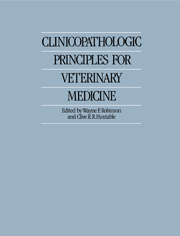Book contents
- Frontmatter
- Contents
- Contributors
- Preface
- Acknowledgements
- 1 The relationship between pathology and medicine
- 2 The immune system
- 3 The hematopoietic system
- 4 Acid–base balance
- 5 The respiratory system
- 6 The cardiovascular system
- 7 The alimentary tract
- 8 The liver and exocrine pancreas
- 9 The urinary system
- 10 The endocrine glands
- 11 The skin
- 12 The skeletal system
- 13 The nervous system
- 14 Muscle
- 15 Metabolic disease
- 16 The reproductive system
- Index
11 - The skin
Published online by Cambridge University Press: 19 January 2010
- Frontmatter
- Contents
- Contributors
- Preface
- Acknowledgements
- 1 The relationship between pathology and medicine
- 2 The immune system
- 3 The hematopoietic system
- 4 Acid–base balance
- 5 The respiratory system
- 6 The cardiovascular system
- 7 The alimentary tract
- 8 The liver and exocrine pancreas
- 9 The urinary system
- 10 The endocrine glands
- 11 The skin
- 12 The skeletal system
- 13 The nervous system
- 14 Muscle
- 15 Metabolic disease
- 16 The reproductive system
- Index
Summary
The skin, being the outward manifestation of the body, is often admired, but frequently misunderstood by the everyday observer. The ‘real’ organs, it would seem, are wrapped in the dark mysteries of the interior while the skin is somehow set apart – a sort of bloodless, hairy and inert covering, useful for turning into shoes, handbags or rugs.
The well-trained biologist knows better; the skin is a marvellous adaptation of living tissue directly confronting the stresses and hazards of the environment. It is one of the largest organs in the body and no other tissue has the same problems to overcome. Consider the requirements for its design. It must be strong but elastic, pliable and resilient, and must be able to repair itself quickly. It must be able to resist desiccation – a particularly difficult accomplishment for an exposed system of living cells. It must protect against onslaughts chemical, physical, thermal and microbiologic. It must provide for the reception of countless sensory inputs needed for adequate proprioception and it must provide visual, olfactory and tactile stimuli for sexual and special species-related behavior. In wild animals this includes camouflage.
Far from being inert, the skin is very much alive in spite of its large non-living keratin component. It is interlocked with general body metabolism and has especially strong links with the endocrine and nervous systems. Its construction ensures that it is able to carry out these special functions.
- Type
- Chapter
- Information
- Clinicopathologic Principles for Veterinary Medicine , pp. 275 - 297Publisher: Cambridge University PressPrint publication year: 1988



